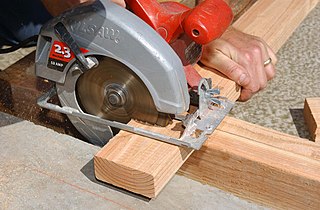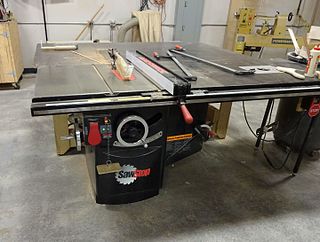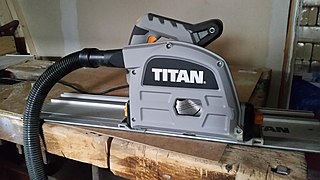
A circular saw or a buzz saw, is a power-saw using a toothed or abrasive disc or blade to cut different materials using a rotary motion spinning around an arbor. A hole saw and ring saw also use a rotary motion but are different from a circular saw. Circular saws may also be loosely used for the blade itself. Circular saws were invented in the late 18th century and were in common use in sawmills in the United States by the middle of the 19th century.
A power tool is a tool that is actuated by an additional power source and mechanism other than the solely manual labor used with hand tools. The most common types of power tools use electric motors. Internal combustion engines and compressed air are also commonly used. Tools directly driven by animal power are not generally considered power tools.

A table saw is a woodworking tool, consisting of a circular saw blade, mounted on an arbor, that is driven by an electric motor. The drive mechanism is mounted below a table that provides support for the material, usually wood, being cut, with the blade protruding up through the table into the material.

Electronic stability control (ESC), also referred to as electronic stability program (ESP) or dynamic stability control (DSC), is a computerized technology that improves a vehicle's stability by detecting and reducing loss of traction (skidding). When ESC detects loss of steering control, it automatically applies the brakes to help steer the vehicle where the driver intends to go. Braking is automatically applied to wheels individually, such as the outer front wheel to counter oversteer, or the inner rear wheel to counter understeer. Some ESC systems also reduce engine power until control is regained. ESC does not improve a vehicle's cornering performance; instead, it helps reduce the chance of the driver losing control of the vehicle.

A radial arm saw is a cutting machine consisting of a circular saw mounted on a sliding horizontal arm. Invented by Raymond DeWalt in 1922, the radial arm saw was the primary tool used for cutting long pieces of stock to length until the introduction of the power miter saw in the 1970s.

A bandsaw is a power saw with a long, sharp blade consisting of a continuous band of toothed metal stretched between two or more wheels to cut material. They are used principally in woodworking, metalworking, and lumbering, but may cut a variety of materials. Advantages include uniform cutting action as a result of an evenly distributed tooth load, and the ability to cut irregular or curved shapes like a jigsaw. The minimum radius of a curve is determined by the width of the band and its kerf. Most bandsaws have two wheels rotating in the same plane, one of which is powered, although some may have three or four to distribute the load. The blade itself can come in a variety of sizes and tooth pitches, which enables the machine to be highly versatile and able to cut a wide variety of materials including wood, metal and plastic.

The United States Consumer Product Safety Commission is an independent agency of the United States government. The CPSC seeks to promote the safety of consumer products by addressing "unreasonable risks" of injury ; developing uniform safety standards ; and conducting research into product-related illness and injury. In part due to its small size, the CPSC attempts to coordinate with outside parties—including companies and consumer advocates—to leverage resources and expertise to achieve outcomes that advance consumer safety. The agency was created in 1972 through the Consumer Product Safety Act. The agency reports to Congress and the President; it is not part of any other department or agency in the federal government. The CPSC has five commissioners, who are nominated by the president and confirmed by the Senate for staggered seven-year terms. Historically, the commission was often run by three commissioners or fewer. Since 2009, however, the agency has generally been led by five commissioners, one of whom serves as chairman. The commissioners set policy for the CPSC. The CPSC is headquartered in Bethesda, Maryland.
Dremel is a multinational brand of power tools, focusing on home improvement and hobby applications. Dremel is known primarily for its rotary tools, such as the Dremel 3000, 4000 and 8200 series, which are similar to the pneumatic die grinders used in the metalworking industry by tool or moldmakers. Dremel later expanded its product range and now produces butane tools, benchtop and hand-held saws and oscillating tools. The company was purchased by Robert Bosch GmbH in 1993, and is now a division of the Robert Bosch Tool Corporation.

A miter saw or mitre saw is a saw used to make accurate crosscuts and miters in a workpiece by positioning a mounted blade onto a board. A miter saw in its earliest form was composed of a back saw in a miter box, but in modern implementation consists of a powered circular saw that can be positioned at a variety of angles and lowered onto a board positioned against a backstop called the fence.

A rare-earth magnet is a strong permanent magnet made from alloys of rare-earth elements. Developed in the 1970s and 1980s, rare-earth magnets are the strongest type of permanent magnets made, producing significantly stronger magnetic fields than other types such as ferrite or alnico magnets. The magnetic field typically produced by rare-earth magnets can exceed 1.2 teslas, whereas ferrite or ceramic magnets typically exhibit fields of 0.5 to 1 tesla.

SKILSAW Power Tools are a manufacturer of circular saw cutting technology serving the professional construction market. Since 2017, SKILSAW's headquarters have been located in Naperville, Illinois.
Festool is a brand of high-end power tools from Germany. Festool Group GmbH & Co. KG is based in Wendlingen and is a subsidiary of the TTS Tooltechnic Systems holding company. It is known for its system-based approach to power tools and its focus on dust extraction.

Toy safety is the practice of ensuring that toys, especially those made for children, are safe, usually through the application of set safety standards. In many countries, commercial toys must be able to pass safety tests in order to be sold. In the U.S., some toys must meet national standards, while other toys may not have to meet a defined safety standard. In countries where standards exist, they exist in order to prevent accidents, but there have still been some high-profile product recalls after such problems have occurred. The danger is often not due to faulty design; usage and chance both play a role in injury and death incidents as well.

A fence is a part of many woodworking tools; it is typically used to guide or secure a workpiece while it is being sawn, planed, routed or marked. Fences play an important role for both accuracy and safety. Fences are usually straight and vertical, and made from metal, wood or plastic.

Techtronic Industries Company Limited is a Hong Kong–based multinational company that designs, produces, and markets power tools, outdoor power equipment, hand tools, and floor care appliances. It pioneered cordless power tools powered by lithium-ion rechargeable batteries.
Pamela B. Gilbert is an American lawyer and has been a partner of the law firm Cuneo Gilbert & LaDuca, LLP since 2003, where she heads the firm's lobbying practice. Gilbert is a noted consumer rights advocate who has testified before Congress over fifty times and made dozens of appearances in the national print and electronic media. Gilbert leads the Committee to Support Antitrust laws (COSAL), an organization supportive of antitrust legislation.

Vornado is an American firm based in Andover, Kansas, that designs and manufactures household fans and other small appliances related to air circulation. The current incarnation of the company was founded in 1989, two years after the death of Ralph K. Odor (1895-1987), who founded the firm in the 1930s with Ottis A. Sutton in Wichita. The name of the company is a portmanteau of "Vortex" and "Tornado".

Systainers are modular inter-stacking plastic containers used for transporting power tools. Boxes from different manufacturers are compatible and can be stacked and clipped together. A design using four joining clips was introduced by Festool Tooltechnic in 1993. In 2010 the T-Loc variant was introduced using a rotating handle for connecting and locking of containers, in combination with redesigned feet.
An electric motor brake is a safety feature incorporated into many modern power tools, such as circular saws, drills, and miter saws. Many manufacturers implement this feature into tools specifically with a spinning blade or cutter.

A plunge saw or plunge-cut saw is a type of hand-held circular saw which differs from a regular circular saw in that it can plunge into the material to a predetermined depth during the cut. In other words, the depth-of-cut is not fixed and often can be adjusted to be just slightly over the thickness of the board being cut. This property also allows a plunge saw to cut shallow grooves into the workpiece, if necessary. Compared to traditional hand-held circular saws, plunge saws are said to increase operator safety, as well as allowing for reduced splintering and tear-out. Plunge saws are an essential power tool for joiners, carpenters, kitchen fitters and anyone who works with laminates, insulation or needs to make lots of cuts in small work pieces.


















